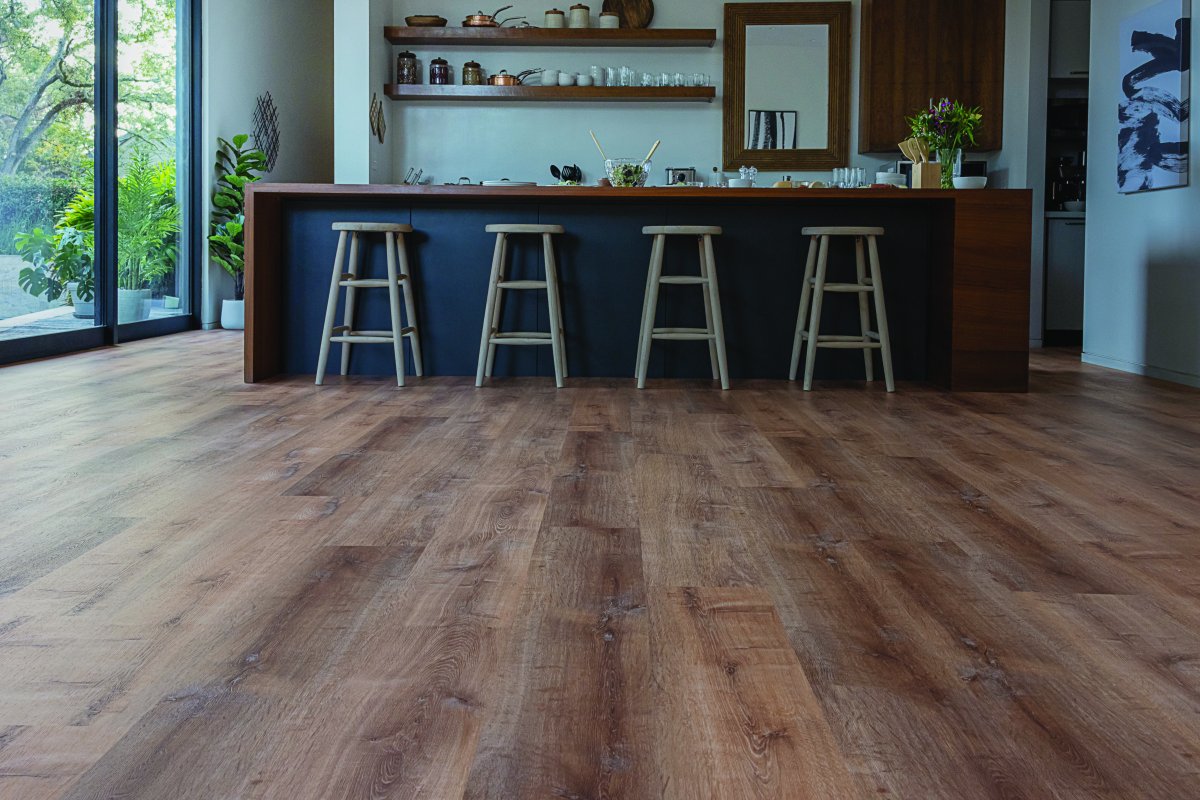

We may earn revenue from the products available on this page and participate in affiliate programs. Learn More ›
With all that goes into kitchens, including plumbing, fixtures, cabinets, flooring, and countertops, it’s little wonder that this central hub of the home is easily the most expensive room in the house to remodel. All told, you’ll spend between $14,500 and $41,500 to remodel your kitchen, according to Angi. Because flooring makes up a significant chunk of that cost, choosing the right material is key. To meet or beat the average 50 percent return on investment that a major kitchen remodel brings, you’ll want flooring that can endure heavy foot traffic and spills, and is timeless enough to span the 10 to 15 years a kitchen remodel should last.
Choosing a kitchen flooring material that can meet those steep demands can be a challenge, given how many options homeowners have from which to choose. Ahead, we reveal the factors you should consider when shopping for kitchen flooring, and recommend our five favorite kitchen flooring materials.
What to Consider When Choosing Kitchen Flooring
Kitchens are both a workspace and the centerpiece of your home, which is why it’s important to consider both form and function when choosing the best kitchen flooring for your space. Here are a few factors to keep in mind when brainstorming kitchen flooring ideas:
- Durability: To withstand frequent spills without staining, and to survive dropped skillets without damage, choose flooring that’s tough enough to survive your lifestyle.
- Water-resistance: The kitchen is a “semi-wet” room, so the flooring you choose should be fairly impervious to the occasional spilled glass of juice, or overturned pet water bowl.
- Scrubbable: Messes always seem to end up underfoot, so the best kitchen flooring is one that’s easy to keep clean.
- Design-friendly: When all is said and done, you want your kitchen to look just as stylish as the rest of your home. With today’s flooring options, you can have an attractive kitchen floor that’s resilient to boot.
1. Sheet Vinyl
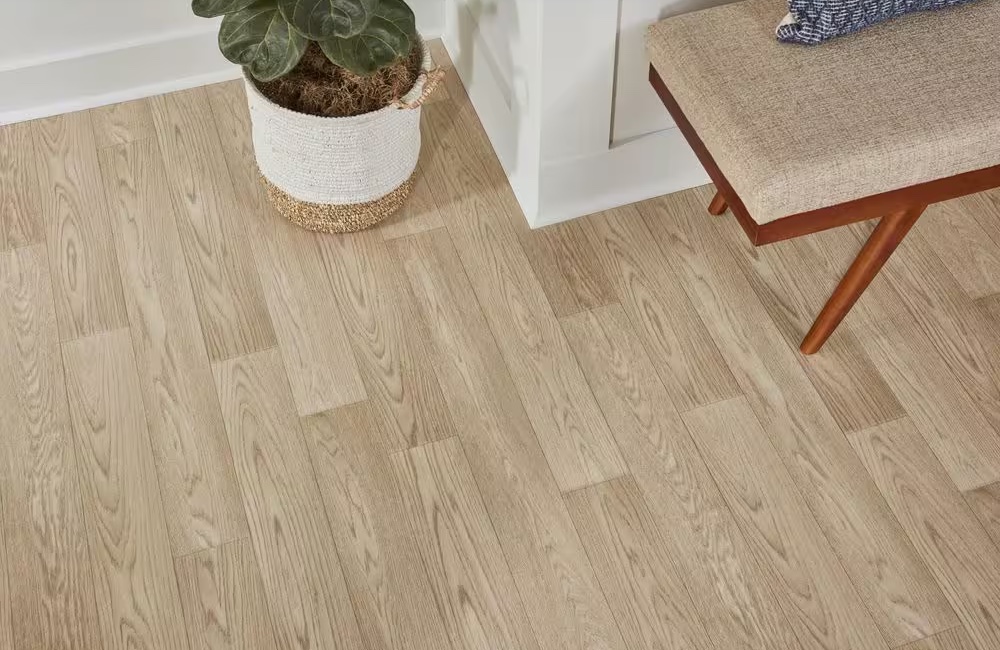
Sheet vinyl has been around for decades, and has only gotten better. The fact that it comes in a large sheet, as opposed to small, stick-down tiles, means there are very few seams through which water can seep down to the subflooring. Sheet vinyl is one of the best types of kitchen flooring because it offers wall-to-wall waterproof floor protection, a boon in busy kitchens that see a lot of spills.
Vinyl flooring doesn’t get cold in the winter (as, say, ceramic tile can), so it’s comfortable underfoot all year round. Vinyl flooring is easy to clean, too; regular sweeping and occasional mopping with an all-purpose vinyl floor cleaner is sufficient.
Sheet vinyl is available in a wide variety of patterns and colors. The thicker the vinyl, the more durable and the more expensive it tends to be. Expect to pay $1 to $2 per square foot depending on quality. Professional installation will add another $1 to $5 per square foot. Professional installation is recommended because the vinyl sheet must be perfectly cut to fit the exact dimensions of the room and then carefully glued and rolled with a heavy press to prevent air bubbles.
Pros: Water-resistant, scrubbable, comfortable underfoot, and budget friendly
Cons: Heavy appliances can leave depressions in the vinyl (this is avoidable with coasters under appliance legs)
Our recommendation: TrafficMaster Vinyl Sheet Flooring – Get it at The Home Depot for $1/square foot.
At around $1 per square foot, TrafficMaster sheet vinyl is one of the most affordable modern kitchen flooring options you can choose. It’s completely waterproof and has a PVC wear layer that’s tough enough to withstand the abuse a kitchen floor takes. Plus, TrafficMaster comes in dozens of designs that resemble popular kitchen flooring materials such as wood, ceramic tile, and marble.
2. Luxury Vinyl Plank (LVP)
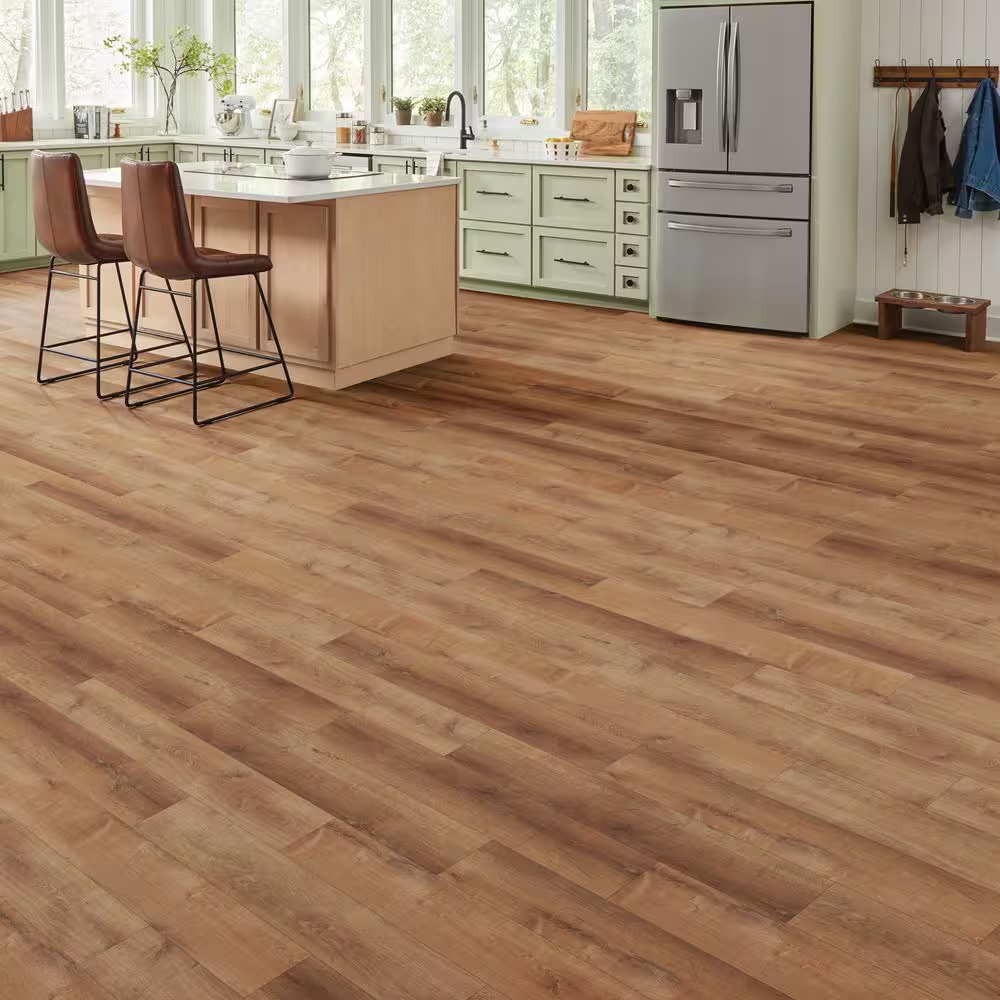
One of the newer flooring products on the market, luxury vinyl plank (LVP) is getting a lot of attention, and for good reason. The planks, which resemble hardwood, are completely waterproof. On the surface of the engineered plank is a layer of luxury vinyl, bonded to a waterproof core that’s slightly cushioned to give the floor a soft feel underfoot.
Like other engineered flooring (laminate flooring or floating flooring), vinyl planks do not attach directly to the subfloor. Instead, the planks snap together, which makes installation DIY-friendly. You’ll save money if you install vinyl plank flooring yourself: The flooring runs $2 to $10 per square foot and includes installation instructions. If you choose to have it professionally installed, expect to pay another $3 to $10 per square foot. Unlike many flooring choices, such as sheet vinyl or tile, LVP can be installed directly over existing tile, concrete, or linoleum. These attractive characteristics are why LVP is rapidly becoming the most popular kitchen flooring.
In terms of downsides, vinyl plank is not as resilient as porcelain—and scooting a heavy refrigerator across its surface could leave a scratch, so care should be taken when moving heavy appliances. It’s a breeze to clean, however, with just a mop dampened with soapy water.
Pros: Waterproof, DIY-friendly, closely resembles real hardwood flooring
Cons: Heavy appliances may leave depressions
Our recommendation: Lifeproof Click Lock Waterproof Luxury Vinyl Plank Flooring – Get it at The Home Depot for $3.28/square foot.
With its combination of durability and aesthetics, Lifeproof luxury vinyl plank has the look and feel of hardwood and the wear resistance of vinyl. It’s waterproof, has an antimicrobial treatment that resists mildew and mold growth, and resists scratches. Lifeproof has an embossed surface, so it looks like real hardwood, and it comes in a variety of finishes.
3. Porcelain Tile
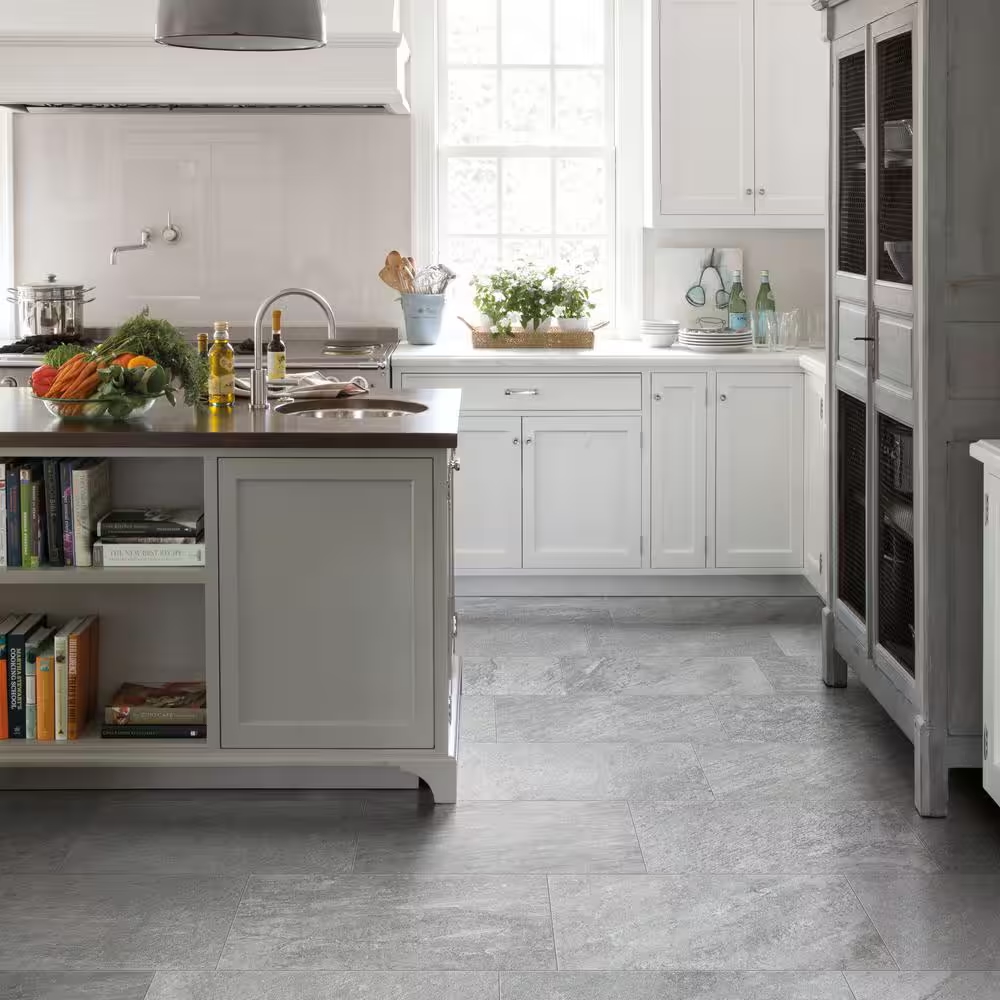
For the ultimate in durability, it’s hard to beat porcelain tile, as it is among the best tiles for a kitchen floor. Though similar in appearance to ceramic tile, porcelain is fired at higher temperatures, which makes it stronger and more resistant to damage. It comes in a variety of sizes and shapes, from 6-inch squares to 18-inch planks that resemble hardwood. Like other hard flooring surfaces, porcelain can be slippery when wet, and it’s extremely hard—glasses and plates that fall on the floor will likely shatter.
Porcelain tile is heavy and will add substantial weight, so it’s not usually recommended for a second-story floor. If you have questions about whether your floor system is adequate for installing the tile, contact an engineer or a reputable tile setter. Depending on brand and quality, you’ll pay $0.50 to $15 per square foot for porcelain tile and an additional $4 to $32 per square foot for professional installation. Unless you’re familiar with laying tile, it’s best to leave this job to the pros. Installing porcelain requires the use of a special type of underlayment and thinset mortar.
Though porcelain tile is easy to clean with an all-purpose floor cleaner and a wet mop, the grout between the tiles should be sealed every 3 to 4 years with a grout sealer to reduce the risk of stains.
Pros: Extremely durable, waterproof, stain resistant, and good for high-traffic areas
Cons: Grout requires periodic sealing to prevent stains
Our recommendation: Corso Italia Porcelain Floor and Wall Tile – Get it at The Home Depot for $1.99/ square foot.
Corso Italia’s porcelain tile’s design and durability makes it a perfect pick for kitchens. It closely resembles the look of stone, and comes in 12-inch by 24-inch sizes that suit the floors of larger kitchens. And since Corso Italia tile comes with grade 4 abrasion resistance, it’s built to endure heavy traffic areas.
4. Stone Tile
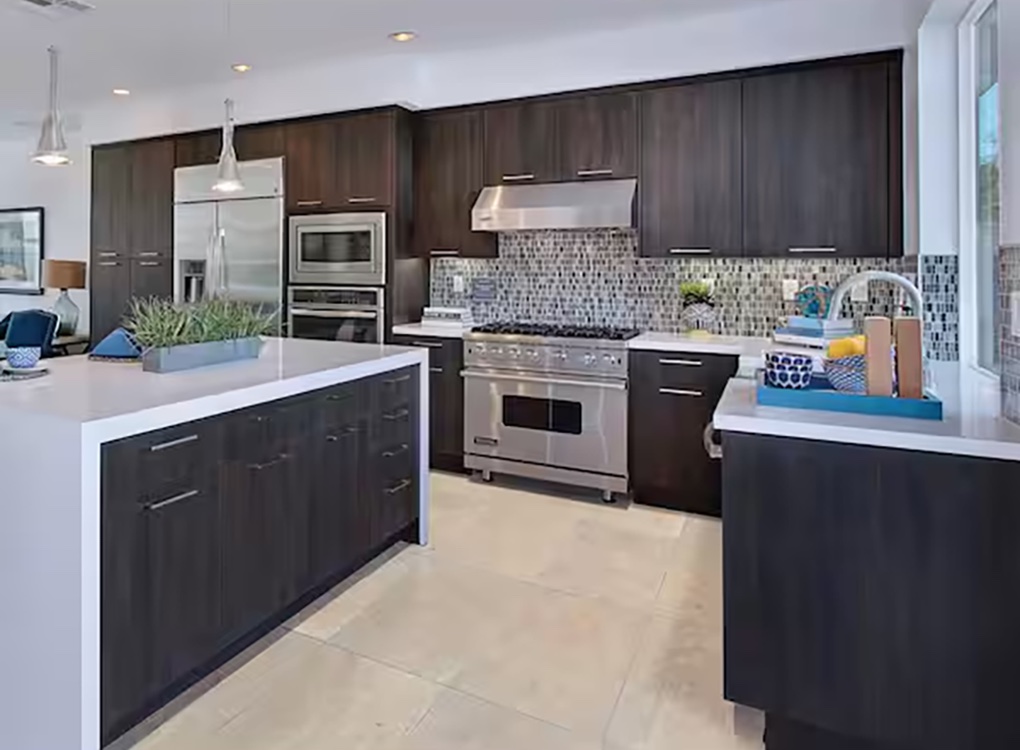
If you want natural flooring at any price, check out stone tile. You’ll pay $5 to $45 per square foot, depending on the type of stone, and you’ll have to factor in an additional $3 to $15 per square foot for professional installation. Hiring a professional tile setter is highly recommended because of the special underlayment and thinset mortar required. Even slight discrepancies in the thickness of the mortar or failure to use the correct product could result in stone tiles popping off.
Natural stone tile adds beauty to any kitchen and, unlike manufactured tiles, it’s by and large nonslip due to its semi-porous surface. Choose from a handful of natural tan, gray, red, and brown earth tones, depending on the type of stone you choose. The following types of stone are commonly available in flooring tiles:
- Travertine tile is smooth underfoot, nonslip, and available in light-to-medium soft earth tones.
- Marble is very hard and can be polished to a high sheen. Unfortunately, it can also be slippery when wet. Marble flooring is available in a wide variety of colors, including green, brown, gray, and near-black with pink, red, gold, and burgundy veining.
- Slate flooring is one of the best kitchen flooring choices for a number of reasons, namely because it’s slip-resistant and very durable. It is available in blue, gray, red, and orange tones, with attractive veining in the same colors.
- Granite tile is very hard, making it a good choice for high traffic areas. It comes in deep grays, blacks, tans, and mottled white tones. Granite resists scratching and can be polished to high shine, although the higher the sheen, the greater the slip factor.
Natural stone tiles are available in squares as small as 2 inches (for creating a mosaic look), and as large as 18 inches for a more streamlined design. Clean your stone tile floor with a wet mop and soapy water. Follow the tile manufacturer’s recommendations for sealing the floor, to protect it from stains and discoloration, every 2 to 4 years.
Pros: Adds a natural, one-of-a-kind ambiance (no two tiles are identical), nonslip surface
Cons: Expensive and can stain without regular sealing
Our recommendation: MSI Castle Honed Travertine Floor and Wall Tile – Get it at The Home Depot for $3/square foot.
This travertine floor tile comes in large 18-inch by 18-inch tiles that are just right for kitchen floors. It’s available in a variety of finishes, making it easier to match with cabinets and countertops. And since MSI stone tile is rated for outdoor as well as indoor use, you can rest assured that it’s tough enough for kitchen floor duty.
5. Cork

A relatively new addition to the flooring market, cork flooring is quickly becoming a preferred choice for those who want a warm, soft floor at an affordable price. Expect to pay $3 to $9 per square foot for cork tiles in square or plank shapes. Cork tiles can be installed by an enthusiastic homeowner: They’re available in peel-and-stick, glue down, or snap-together assembly. If you go the route of professional installation, it will run you an additional $2 to $9 per square foot, depending on the type of installation.
Composed of ground-up cork combined with resins and then compressed into firm tiles, cork flooring is available in a variety of gray, tan, and brown shades. While cork can depress under the legs of heavy appliances, given time, depressions will return to their original state. On the upside, cork flooring is soft underfoot and slightly springy. It reduces sound transfer, so it’s a good choice for homes that have a living area beneath the kitchen. Cork flooring resists stains but it is not stain-proof. Spilled wine that’s not promptly wiped up may leave a stain, but one of the cool things about cork is that it can be refinished by sanding down the surface and then applying stain and a sealer.
Cork can fade if exposed to direct sunlight, so you’ll want to protect this type of floor by hanging curtains or blinds in the kitchen. Clean-up is simple; wipe up spills promptly and mop with soapy water when necessary. Follow up by wiping the floor with a clean, dry microfiber mop to remove excess water.
Pros: Budget-friendly, DIY-friendly, warm and cushioned feel underfoot
Cons: Can be scratched by heavy objects
Our recommendation: eco FOREST Savoy Cork Plank – Get it at Floor & Decor for $3.99/square foot.
This cork flooring closely resembles plank hardwood flooring. At nearly a half-inch thick, it absorbs noise well while offering a cushioned landing for feet (and any dishes or glasses that happen to fall off the counter).
